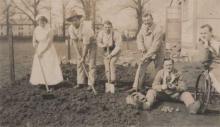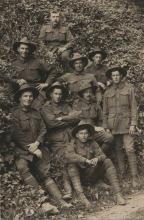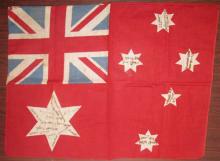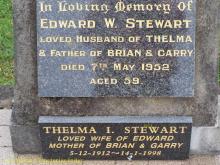Edward William Stewart
As the only son of a farmer, it can be assumed that Edward William Stewart was reluctant to sign up and leave his father to work the family farm Strathleven alone. The family had not long owned the farm, having operated a bakery business in Kiama for many years prior. They had only recently built the farmhouse and were in the process of setting up the farm so there was still much work to be done. Eddie was well known as a sportsman in the district and an excellent marksman; he was a member of the Kiama Rifle Club and had completed successfully at a national level. Therefore when Captain Campbell Carmichael launched a recruiting drive amongst the rifle clubs in NSW to form a Battalion in conjunction with increasing pressure from the government and sections of the community, Eddie may have felt obliged to answer the call. The Battalion raised by Captain Carmichael became the 36th and was known as “Carmichael’s Riflemen” or “Carmichael’s One Thousand”.
After training in camps at Cootamundra and Rutherford, Eddie embarked at Woolloomooloo, Sydney with the 36th Battalion 2nd Reinforcements from “Port Sydney” on 4 September 1916. Whether it was because of secrecy over the sailing date or because of Eddie’s wishes, none of his family was there to see the ship sail. However, Eddie’s best friend George King accompanied Eddie’s unity as it marched down to the ship and was there to wave him off. The voyage to England sailed via Melbourne, Durban and Cape Town; the troops had a couple of days ashore at each port. His letters describing the Durban visit indicate that they had a fairly lively time and they found the locals very friendly. One evening, Eddie was in a residential area of Durban with a noisy lot of mates which led to some of the locals coming out to see the commotion. After seeing the Australians, a couple of families invited them in for supper. In comparison, they found their welcome rather cool in Cape Town. This was not surprising given the predominately Dutch and German backgrounds of the white inhabitants. Eddie and some friends took a train over to Signal Hill to Camp bay and were most impressed with the scenery. They finally arrived in Plymouth, England on 29 October 1916.
In England, Eddie was billeted for training camps on the Salisbury Plain, mainly at Lark Hill. During training, apart from his superior marksmanship, he showed particular skill at throwing Mills Bombs (grenades). The skill was put to good use when he reached the front. He remained in training until 20 December 1916 when he crossed to France. There, he was initially located with other reinforcements at a training camp in the Etaples area and moved up to join the main body of his battalion on 18 January 1917. The 36th Battalion at the time was in the front line trenches in the Nouvel Houplines area of Armentieres, Belgium. The Battalion strength consisted of 36 officers and 976 other ranks commanded by Lieutenant Colonel J.W.A Simpson.
During this period, the Battalion was under heavy bombardment from German artillery. On 21 January, Lieutenant Colonel Simpson and Lieutenant McGrath were killed and give others were wounded by heavy artillery and machine gun fire.
On 22 January, following heavy bombardment by their artillery, the German infantry attacked. A Company of the 36th Battalion was heavily engaged and returned intense fire. The Germans reached the Battalion trenches by were repulsed after about ten minutes of hand-to-hand fighting. The 36th battalion casualties included 15 dead and 36 wounded. This included Eddie who was wounded by shrapnel from a close artillery shell burst. He was hit by about seven shell fragments, the worst wounded being in the right buttock. He would carry some of those fragments in his body for the rest of his life.
After having his wounds dressed by stretcher bearers, Eddie was taken through three different field casualty stations to a British Army hospital in the town of Bailleul. After more treatment there over two days, he was transferred to the Canadian Army hospital in Boulogne where he remained for another five days. From there he was transported by an overnight steamer to Southampton, then to the war hospital at Foxhill, Bath where he arrived on 30 January 1917.
Eddie was in bed for about six weeks and sitting up for another week before he was allowed to walk. On 24 April he was transferred to a convalescent hospital in Dartford, Kent via an Australian Army hospital in London. On 30 April he was given leave and travelled to Irvinestown, County Fermanagh in Northern Ireland travelling via Holyhead, Kingston and Dublin to stay with relatives. A friend of his, Wilkinson from Victoria who had been in the bed next to him at Foxhill hospital accompanied him. Eddie and ‘Wilkie’ stayed with Eddie’s auntie Anne Jane Irwin and her family on their farm in Makenny County Tyrone. Anne Jane was the younger sister of Eddie’s father.
On 13 May, Eddie travelled to Weymouth England via Belfast, Liverpool, London, Westbury and Bath. After a medical check at Weymouth barracks, he was billeted at Perham Downs’ camp from the middle of May until 15 June when he was sent back over to France. On arrival there he remained in a rest camp at Rouelles for four months as his wounds weren’t yet fully healed. He spent most of his time in the camp resting and gardening.
While Eddie had been recuperating in England, the 3rd Australian Division were engaged in the Battle of Messines where the objective was to capture and hold the Messines-Wystschaete ridge. The 9th and 10th Brigades led the assault on 6 and 7 June and the ridge was taken but at a very high cost. The 36th Battalion casualties following this engagement included 66 killed, 318 wounded and 16 missing, mostly in the Ploegstreet Wood area.
On 5 October, the Battalion was still at the front line in Passchendaele in the area of Bremen Redoubt. It was subjected to heavy bombardment and Captain Carmichael of A Company who had been instrumental in the recruitment and formation of the Battalion was hit and wounded.
Eddie rejoined the 36th Battalion in early October 1917. His service records indicate that he rejoined the Battalion on 11 October, however his letters suggest it may have been a couple of days earlier.
Eddie suffered a deep shrapnel wound in the lower right thigh when a shell exploded amongst them as they advanced up to the Passchendaele ridge. After being wounded, he also suffered exposure to mustard gas laid by the Germans that blistered his face and neck causing nausea and vomiting for several days.
After being evacuated from the front line, Eddie was operated on at a field hospital in Ypres to remove the piece of shrapnel which he described as being about the size of a pigeon’s egg. He was taken by train to an Australian Army hospital in Rouen and after a week, he was transported by train to Le Havre and by ship to Southampton. Then finally, after a nine hour train trip he ended up at Walley, near Blackburn in Lancashire.
Eddie was confined to bed for about five weeks as his wound was quite serious and he was finally up on 17 November. He was then moved to Hurdcott Convalescent Camp in Wiltshire at the end of November. Here, he saw quite a lot of Private Harry Galpin (#2076) of the 35th Battalion. Originally from Somerset England, he immigrated to Australia as a young man and found employment on the Stewart farm. He enlisted in the AIF at about the same time as Eddie. Harry was shot in the knee during the Battle of the Ypres. Due to the seriousness of his wound, he was repatriated back to Australia on 1 February 1918. He returned to the Stewart farm. Although he later married and lived in Kiama, he worked on the farm for the remainder of his working life.
Eddie remained at Hurdcott camp until 24 January 1918 when he went on convalescent leave to Ireland where again he stayed with the Irwin family. He returned to Hurdcott camp on 6 February to continue his convalescence. At the end of February, he spent a weekend in Salisbury sightseeing and on 2 March, he moved to Warminster training camp around 29km (18 miles) from Hurdcott.He must have been fully recovered from his wound at this time as he was involved in intense training and guard duties. On 16 March he hired a bicycle and rode just over 35km (22 miles)to Bath and back for the weekend to see his old friends. While at Warminster camp, he represented his division in a rifle shooting competition where he came 4th in the individual and won the team’s event. He received a 10 shilling prize (about $1.00). A Private’s pay at the time was 6 shillings a day (0.60c).
Eddie rejoined the 36th Battalion around 2 April 1918 while they were resting at a camp near the village of Cachey.
On 30 April 1918 the 36th Battalion was disbanded to reinforce other Battalions. Edward William Stewart transferred to A Company of the 33rd Battalion. High casualties had reduced the strength of all 3rd division battalions to about 300 of all ranks. This necessary merge of the depleted battalions was not accepted well by the troops of the disbanded battalions. They had been very proud of their own battalions and their battalion colours.
In August 1918, Eddie was hit by three machine gun bullets. One took off the index finger of his left hand at the knuckle (he was carrying a bag of Mills bombs in that hand). Another bullet left a deep gouge wound across his right buttock and the third: an explosive bullet hit high up on his left thigh leaving a very large exit wound on the inside of his thigh. A friend, believed to be Sergeant Frank Abbot from Penrith who was killed in action the same day applied dressings to Eddie’s wounds and although he was bleeding heavily, he dragged himself into some bushes out of the line of fire and armed himself in readiness for a possible German attack. He was eventually picked up by stretcher bearers, who had passed him by initially for someone who had worse wounds. They returned to collect Eddie when their first patient died on the stretcher. He was the last casualty evacuated from that sector at the time due to the intensity of the machine gun fire.
Following the initial treatment at a field dressing station, Eddie was transported to an English hospital in Rouen where he was operated on. From Rouen, he was taken 128.8 km (80 miles)to Le Havre by hospital train and then a ten hour crossing to Southampton on the hospital steamer Panama. This was followed by a four hour trip by hospital train to Foxhill military hospital at Bath arriving around 3 September.
Eddie was seriously ill for several days due to heavy blood loss but felt better by 9 September even though his condition remained serious. He was allowed to sit up on the bed briefly on 22 October but was still very weak. By 2 November he wrote that his wounds were still discharging and he was still unable to walk.
About 4 November, Eddie was moved to a VA hospital at Bowood, the country home and estate of Lord and Lady Lansdowne. A stately English mansion, Bowood is situated about 24km (15 miles) NE of Bath, about 3.2 km (2 miles) from the village of Valne and just over 8km (5 miles) from Chippenham.Volunteer helpers included Lady Lansdowne, Lady Spicer and Lady Beresford. There were about 60 patients and Eddie was in a group of the first Australians to be sent there. He still wasn’t allowed out of bed. He wrote that the estate had a deer park and many deer could be seen grazing nearby.
On 11 November 1918 – Armistice Day, Germany surrendered. It was very quiet at Eddie’s hospital although he wrote of the great celebration in London. He was still confined to bed on 16 November. His leg wound was still open almost 8cm (3 inches) and his finger had nearly healed. On 1 December, three months after being wounded, he was finally allowed out of bed and shortly after, lady Lansdowne showed him through the house; he described it as magnificent. On 10 December he was moved to an Australian hospital at Harefield, Middlesex about 24km (15 miles)from London. On the way there Eddie had a two hour walk around London and commented on all the flags and bunting.
On 12 December, Eddie left hospital on leave and travelled to Ireland to stay with the Irwin family once again. His leg wound was still open and discharging at this stage. He over extended himself travelling around visiting relatives and became ill for a few days. He remained in Ireland for Christmas having Christmas dinner with the Irwin family and other relatives; there were 21 of them. He left Ireland on Boxing Day travelling via Dublin to Weymouth where he was billeted in Horseferry Road.
In Weymouth, Eddie was attached to No.2 Weymouth Command Depot. He spent his time resting and attending picture shows, concerts and socials. On 17 January 1919 he was issued with his boat ticket home and spent his last night in Weymouth at the movies. On 18 January he was marched to Weymouth Station and travelled by train to Plymouth. Enroute the train stopped at Exeter Station where the Lady Mayoress, assisted by other local ladies served tea and buns. Eddie wrote that all Australian soldiers passing through Exeter during the war were similarly treated
On arrival in Plymouth, Eddie boarded the SS Margha a coal burning twin-screw steamer. Eddie was fortunate to be assigned a bunk in a cabin for the trip. It was raining when ship set sail at 7.30am on 19 January 1919.
The voyage home via Port Said, Port Suez, Colombo, Fremantle, Adelaide, Melbourne and Hobart was relatively uneventful and Eddie was bored and anxious to get home. They were allowed ashore for only seven hours in Colombo.
The SS Margha arrived in Sydney on Sunday 9 March 1919. Following medical checks and other discharge procedures late on Tuesday afternoon 11 March, Eddie finally boarded a train for Kiama. He was not expecting the huge crowd that was waiting at Kiama railway station that evening or the local brass bands or the speech by the Mayor of Kiama, Walter Cornford. He was overcome by emotion and barely able to respond but was finally able to get into the car with his family and return home to the farm and celebrate with friends and family at his welcome home party.
Links
Trove Links
- WELCOME HOME. CORPL. EDDIE STEWART. - The Kiama Independent, and Shoalhaven Advertiser (NSW : 1863 - 1947) - http://trove.nla.gov.au/ndp/del/article/102744812?searchTerm=welcome+home++ed...
- MR. E. W. STEWART - Kiama Independent (NSW : 1947 - 1954) - http://trove.nla.gov.au/ndp/del/article/101647738?searchTerm=edward+william+s...
- PTE. E. STEWART. - The Kiama Independent, and Shoalhaven Advertiser (NSW : 1863 - 1947) - http://trove.nla.gov.au/ndp/del/article/102745262?searchTerm=eddie+stewart+kiama





